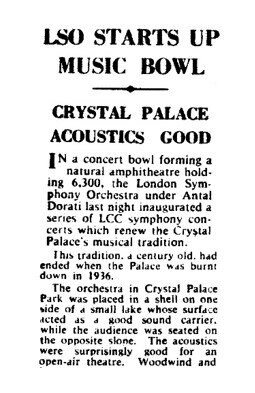Renewing a musical tradition.
In the aftermath of the Second World War, during which the grounds of the Crystal Palace had been requisitioned by the military, the responsibility for the park fell to the LCC and later the GLC (London County Council and Greater London Council).
After the huge success of the 1951 Festival of Britain on London’s South Bank (directly inspired by the 1851 Great Exhibition at Crystal Palace) and in the spirit of post-war optimism, an ambitious new masterplan was developed in 1955 for the scarred and dilapidated park, which had been closed to the public since the destruction of the Palace by fire in 1936.
This included a national exhibition and sports centre, a 160ft high observation tower and an acoustic shell stage for open air concerts
An elegant concrete and steel stage design in the prevailing modernist ‘Festival’ style was proposed, to be sited opposite the small lake and facing the natural amphitheatre of the ‘English Garden Landscape’. This concept design was never built, however preparatory work was soon begun on a temporary stage that would enable music to finally return to the park.
In June 1961, the new Crystal Palace Concert Bowl opened with a performance by the London Symphony Orchestra conducted by Antal Dorati, resuming a musical tradition at the Palace that stretched back more than a century to the great Handel Festivals and pre-war Brass Band Championships. The ‘Music in the Open Air’ and 'Proms in the Park' classic concerts grew in popularity throughout the 1960’s and became a popular annual fixture, establishing Crystal Palace as firm favourite for deckchairs, picnics, Pimms and music on a summers evening. The classical concerts continued in various forms and with differing orchestras for over 45 years until circa 2007.





